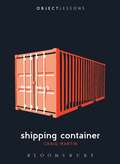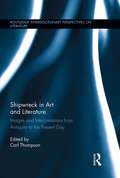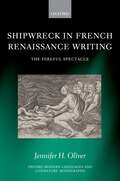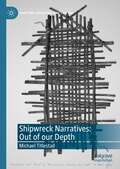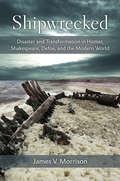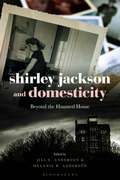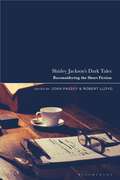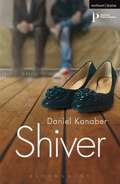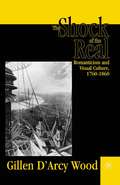- Table View
- List View
Shipboard Literary Cultures: Reading, Writing, and Performing at Sea (Maritime Literature and Culture)
by Susann Liebich Laurence PublicoverThe essays collected within this volume ask how literary practices are shaped by the experience of being at sea—and also how they forge that experience. Individual chapters explore the literary worlds of naval ships, whalers, commercial vessels, emigrant ships, and troop transports from the seventeenth to the twentieth-first century, revealing a rich history of shipboard reading, writing, and performing. Contributors are interested both in how literary activities adapt to the maritime world, and in how individual and collective shipboard experiences are structured through—and framed by—such activities. In this respect, the volume builds on scholarship that has explored reading as a spatially situated and embodied practice. As our contributors demonstrate, the shipboard environment and the ocean beyond it place the mind and body under peculiar forms of pressure, and these determine acts of reading—and of writing and performing—in specific ways.
Shipping Container (Object Lessons)
by Craig MartinObject Lessons is a series of short, beautifully designed books about the hidden lives of ordinary things. The shipping container is all around: whizzing by on the highway, trundling past on rails, unloading behind a big box store even as you shop there, clanking on the docks just out of sight…. 90% of the goods and materials that move around the globe do so in shipping containers. It is an absolutely ubiquitous object, even if most of us have no direct contact with it. But what is this thing? Where has it been, and where is it going? Craig Martin's book illuminates the "development of containerization†?-including design history, standardization, aesthetics, and a surprising speculative discussion of the futurity of shipping containers.Object Lessons is published in partnership with an essay series in the The Atlantic.
Shipping Container (Object Lessons)
by Craig MartinObject Lessons is a series of short, beautifully designed books about the hidden lives of ordinary things. The shipping container is all around: whizzing by on the highway, trundling past on rails, unloading behind a big box store even as you shop there, clanking on the docks just out of sight…. 90% of the goods and materials that move around the globe do so in shipping containers. It is an absolutely ubiquitous object, even if most of us have no direct contact with it. But what is this thing? Where has it been, and where is it going? Craig Martin's book illuminates the “development of containerization”-including design history, standardization, aesthetics, and a surprising speculative discussion of the futurity of shipping containers.Object Lessons is published in partnership with an essay series in the The Atlantic.
Shipwreck in Art and Literature: Images and Interpretations from Antiquity to the Present Day (Routledge Interdisciplinary Perspectives on Literature)
by Carl ThompsonTales of shipwreck have always fascinated audiences, and as a result there is a rich literature of suffering at sea, and an equally rich tradition of visual art depicting this theme. Exploring the shifting semiotics and symbolism of shipwreck, the interdisciplinary essays in this volume provide a history of a major literary and artistic motif as they consider how depictions have varied over time, and across genres and cultures. Simultaneously, they explore the imaginative potential of shipwreck as they consider the many meanings that have historically attached to maritime disaster and suffering at sea. Spanning both popular and high culture, and addressing a range of political, spiritual, aesthetic and environmental concerns, this cross-cultural, comparative study sheds new light on changing attitudes to the sea, especially in the West. In particular, it foregrounds the role played by the maritime in the emergence of Western modernity, and so will appeal not only to those interested in literature and art, but also to scholars in history, geography, international relations, and postcolonial studies.
Shipwreck in Art and Literature: Images and Interpretations from Antiquity to the Present Day (Routledge Interdisciplinary Perspectives on Literature)
by Carl Thompson Carl D. ThompsonTales of shipwreck have always fascinated audiences, and as a result there is a rich literature of suffering at sea, and an equally rich tradition of visual art depicting this theme. Exploring the shifting semiotics and symbolism of shipwreck, the interdisciplinary essays in this volume provide a history of a major literary and artistic motif as they consider how depictions have varied over time, and across genres and cultures. Simultaneously, they explore the imaginative potential of shipwreck as they consider the many meanings that have historically attached to maritime disaster and suffering at sea. Spanning both popular and high culture, and addressing a range of political, spiritual, aesthetic and environmental concerns, this cross-cultural, comparative study sheds new light on changing attitudes to the sea, especially in the West. In particular, it foregrounds the role played by the maritime in the emergence of Western modernity, and so will appeal not only to those interested in literature and art, but also to scholars in history, geography, international relations, and postcolonial studies.
Shipwreck in French Renaissance Writing (Oxford Modern Languages and Literature Monographs)
by Jennifer H. OliverIn the sixteenth century, a period of proliferating transatlantic travel and exploration, and, latterly, religious civil wars in France, the ship is freighted with political and religious, as well as poetic, significance; symbolism that reaches its height when ships—both real and symbolic—are threatened with disaster. The Direful Spectacle argues that, in the French Renaissance, shipwreck functions not only as an emblem or motif within writing, but as a part, or the whole, of a narrative, in which the dynamics of spectatorship and of co-operation are of constant concern. The possibility of ethical distance from shipwreck—imagined through the Lucretian suave mari magno commonplace—is constantly undermined, not least through a sustained focus on the corporeal. This book examines the ways in which the ship and the body are made analogous in Renaissance shipwreck writing; bodies are described and allegorized in nautical terms, and, conversely, ships themselves become animalized and humanized. Secondly, many texts anticipate that the description of shipwreck will have an affect not only on its victims, but on those too of spectators, listeners, and readers. This insistence on the physicality of shipwreck is also reflected in the dynamic of bricolage that informs the production of shipwreck texts in the Renaissance. The dramatic potential of both the disaster and the process of rebuilding is exploited throughout the century, culminating in a shipwreck tragedy. By the late Renaissance, shipwreck is not only the end, but often forms the beginning of a story.
Shipwreck in French Renaissance Writing (Oxford Modern Languages and Literature Monographs)
by Jennifer H. OliverIn the sixteenth century, a period of proliferating transatlantic travel and exploration, and, latterly, religious civil wars in France, the ship is freighted with political and religious, as well as poetic, significance; symbolism that reaches its height when ships—both real and symbolic—are threatened with disaster. The Direful Spectacle argues that, in the French Renaissance, shipwreck functions not only as an emblem or motif within writing, but as a part, or the whole, of a narrative, in which the dynamics of spectatorship and of co-operation are of constant concern. The possibility of ethical distance from shipwreck—imagined through the Lucretian suave mari magno commonplace—is constantly undermined, not least through a sustained focus on the corporeal. This book examines the ways in which the ship and the body are made analogous in Renaissance shipwreck writing; bodies are described and allegorized in nautical terms, and, conversely, ships themselves become animalized and humanized. Secondly, many texts anticipate that the description of shipwreck will have an affect not only on its victims, but on those too of spectators, listeners, and readers. This insistence on the physicality of shipwreck is also reflected in the dynamic of bricolage that informs the production of shipwreck texts in the Renaissance. The dramatic potential of both the disaster and the process of rebuilding is exploited throughout the century, culminating in a shipwreck tragedy. By the late Renaissance, shipwreck is not only the end, but often forms the beginning of a story.
Shipwreck Narratives: Out of our Depth (Maritime Literature and Culture)
by Michael TitlestadShipwreck Narratives: Out of Our Depth studies both the representation of shipwreck and the ways in which shipwrecks are used in creative, philosophical, and political works. The first part of the book examines historical shipwreck narratives published over a period of two centuries and their legacies. Michael Titlestad points to a range of narrative conventions, literary tropes and questions concerning representation and its limits in narratives about these historic shipwrecks. The second part engages novels, poems, films, artwork, and musical composition that grapple with shipwreck. Collectively the chapters suggest the spectacular productivity of shipwreck narrative; the multiple ways in which its concerns and logic have inspired anxious creativity in the last century. Titlestad recognizes in weaving in his personal experience that shipwreck—the destruction of form and the advent of disorder—could be seen not only as a corollary for his own neurological disorder, but also an abiding principle in tropology. This book describes how shipwreck has figured in texts (from historical narratives to fiction, film and music) as an analogue for emotional, psychological, and physical fragmentation.
Shipwrecked: Disaster and Transformation in Homer, Shakespeare, Defoe, and the Modern World
by James V. MorrisonShipwrecked: Disaster and Transformation in Homer, Shakespeare, Defoe, and the Modern World presents the first comparative study of notable literary shipwrecks from the past four thousand years, focusing on Homer’s Odyssey, Shakespeare’s The Tempest, and Defoe’s Robinson Crusoe. James V. Morrison considers the historical context as well as the “triggers” (such as the 1609 Bermuda shipwreck) that inspired some of these works, and modern responses such as novels (Golding’s Lord of the Flies, Coetzee’s Foe, and Gordon’s First on Mars, a science fiction version of the Crusoe story), movies, television (Forbidden Planet, Cast Away, and Lost), and the poetry and plays of Caribbean poets Derek Walcott and Aimé Césaire. The recurrent treatment of shipwrecks in the creative arts demonstrates an enduring fascination with this archetypal scene: a shipwreck survivor confronting the elements. It is remarkable, for example, that the characters in the 2004 television show Lost share so many features with those from Homer’s Odyssey and Shakespeare’s The Tempest. For survivors who are stranded on an island for some period of time, shipwrecks often present the possibility of a change in political and social status—as well as romance and even paradise. In each of the major shipwreck narratives examined, the poet or novelist links the castaways’ arrival on a new shore with the possibility of a new sort of life. Readers will come to appreciate the shift in attitude toward the opportunities offered by shipwreck: older texts such as the Odyssey reveals a trajectory of returning to the previous order. In spite of enticing new temptations, Odysseus—and some of the survivors in The Tempest—revert to their previous lives, rejecting what many might consider paradise. Odysseus is reestablished as king; Prospero travels back to Milan. In such situations, we may more properly speak of potential transformations. In contrast, many recent shipwreck narratives instead embrace the possibility of a new sort of existence. That even now the shipwreck theme continues to be treated, in multiple media, testifies to its long-lasting appeal to a very wide audience.
Shirley Jackson and Domesticity: Beyond the Haunted House
by Melanie R. Anderson Jill E. AndersonShirley Jackson and Domesticity takes on American horror writer Shirley Jackson's domestic narratives – those fictionalized in her novels and short stories as well as the ones captured in her memoirs – to explore the extraordinary and often supernatural ways domestic practices and the ecology of the home influence Jackson's storytelling.Examining various areas of homemaking – child-rearing and reproduction, housekeeping, architecture and spatiality, the housewife mythos – through the theoretical frameworks of gothic, queer, gender, supernatural, humor, and architectural studies, this collection contextualizes Jackson's archive in a Cold War framework and assesses the impact of the work of a writer seeking to question the status quo of her time and culture.
Shirley Jackson and Domesticity: Beyond the Haunted House
Shirley Jackson and Domesticity takes on American horror writer Shirley Jackson's domestic narratives – those fictionalized in her novels and short stories as well as the ones captured in her memoirs – to explore the extraordinary and often supernatural ways domestic practices and the ecology of the home influence Jackson's storytelling.Examining various areas of homemaking – child-rearing and reproduction, housekeeping, architecture and spatiality, the housewife mythos – through the theoretical frameworks of gothic, queer, gender, supernatural, humor, and architectural studies, this collection contextualizes Jackson's archive in a Cold War framework and assesses the impact of the work of a writer seeking to question the status quo of her time and culture.
Shirley Jackson, Influences and Confluences
by Melanie R. Anderson Lisa KrögerThe popularity of such widely known works as "The Lottery" and The Haunting of Hill House has tended to obscure the extent of Shirley Jackson's literary output, which includes six novels, a prodigious number of short stories, and two volumes of domestic sketches. Organized around the themes of influence and intertextuality, this collection places Jackson firmly within the literary cohort of the 1950s. The contributors investigate the work that informed her own fiction and discuss how Jackson inspired writers of literature and film. The collection begins with essays that tease out what Jackson's writing owes to the weird tale, detective fiction, the supernatural tradition, and folklore, among other influences. The focus then shifts to Jackson's place in American literature and the impact of her work on women's writing, campus literature, and the graphic novelist Alison Bechdel. The final two essays examine adaptations of The Haunting of Hill House and Jackson's influence on contemporary American horror cinema. Taken together, the essays offer convincing evidence that half a century following her death, readers and writers alike are still finding value in Jackson’s words.
Shirley Jackson, Influences and Confluences
by Melanie R. Anderson Lisa KrögerThe popularity of such widely known works as "The Lottery" and The Haunting of Hill House has tended to obscure the extent of Shirley Jackson's literary output, which includes six novels, a prodigious number of short stories, and two volumes of domestic sketches. Organized around the themes of influence and intertextuality, this collection places Jackson firmly within the literary cohort of the 1950s. The contributors investigate the work that informed her own fiction and discuss how Jackson inspired writers of literature and film. The collection begins with essays that tease out what Jackson's writing owes to the weird tale, detective fiction, the supernatural tradition, and folklore, among other influences. The focus then shifts to Jackson's place in American literature and the impact of her work on women's writing, campus literature, and the graphic novelist Alison Bechdel. The final two essays examine adaptations of The Haunting of Hill House and Jackson's influence on contemporary American horror cinema. Taken together, the essays offer convincing evidence that half a century following her death, readers and writers alike are still finding value in Jackson’s words.
Shirley Jackson’s Dark Tales: Reconsidering the Short Fiction
by Joan Passey and Robert LloydThe first dedicated exploration of the short fiction of Shirley Jackson for three decades, this volume takes an in-depth look at the themes and legacies of her 200-plus short stories. Recognized as the mother of contemporary horror, scholars from across the globe, and from a range of different disciplinary backgrounds, dig into the lasting impact of her work in light of its increasing relevance to contemporary critical preoccupations and the re-release of Jackson's work in 2016. Offering new methodologies to study her work, this volume calls upon ideas of intertextuality, ecocriticism and psychoanalysis to examine a broad range of themes from national identity, race, gender and class to domesticity, the occult, selfhood and mental illness. With consideration of her blockbuster works alongside later works that received much less critical attention, Shirley Jackson's Dark Tales promises a rich and dynamic expansion on previous scholarship of Jackson's oeuvre, both bringing her writing into the contemporary conversation, and ensuring her place in the canon of Horror fiction.
Shirley Jackson’s Dark Tales: Reconsidering the Short Fiction
The first dedicated exploration of the short fiction of Shirley Jackson for three decades, this volume takes an in-depth look at the themes and legacies of her 200-plus short stories. Recognized as the mother of contemporary horror, scholars from across the globe, and from a range of different disciplinary backgrounds, dig into the lasting impact of her work in light of its increasing relevance to contemporary critical preoccupations and the re-release of Jackson's work in 2016. Offering new methodologies to study her work, this volume calls upon ideas of intertextuality, ecocriticism and psychoanalysis to examine a broad range of themes from national identity, race, gender and class to domesticity, the occult, selfhood and mental illness. With consideration of her blockbuster works alongside later works that received much less critical attention, Shirley Jackson's Dark Tales promises a rich and dynamic expansion on previous scholarship of Jackson's oeuvre, both bringing her writing into the contemporary conversation, and ensuring her place in the canon of Horror fiction.
Shiver (Modern Plays)
by Daniel KanaberFrom the despair of aninut, even in a short shiva, the ice inside you is thawing, Mordecai, it will open you to the world if you let it. After, shloshim. After a year, yizkor, yarhrzeit. And yes, sorrow, but also hope, hope in those who'll welcome you, love you. Let them love you. Don't neglect God now that you need him.In Judaism you have seven days to mourn a loved one, unless interrupted by a high holy day. Sadie died yesterday, Yom Kippur is tomorrow, so Mordecai only has tonight to say goodbye to his wife. Exploring themes of identity, love and faith, Shiver is a comic play about grief and Judaism. With moments of farce, as well as a touch of the surreal, this is a skilfully written play that marks the start of an exciting playwriting career for Daniel Kanaber.Shiver received its world premiere at Watford Palace Theatre on 3 February 2014, starring David Horovitch (Hysteria, Hampstead Theatre; Grief, National Theatre; Seven Jewish Children, Royal Court).
Shiver (Modern Plays)
by Daniel KanaberFrom the despair of aninut, even in a short shiva, the ice inside you is thawing, Mordecai, it will open you to the world if you let it. After, shloshim. After a year, yizkor, yarhrzeit. And yes, sorrow, but also hope, hope in those who'll welcome you, love you. Let them love you. Don't neglect God now that you need him.In Judaism you have seven days to mourn a loved one, unless interrupted by a high holy day. Sadie died yesterday, Yom Kippur is tomorrow, so Mordecai only has tonight to say goodbye to his wife. Exploring themes of identity, love and faith, Shiver is a comic play about grief and Judaism. With moments of farce, as well as a touch of the surreal, this is a skilfully written play that marks the start of an exciting playwriting career for Daniel Kanaber.Shiver received its world premiere at Watford Palace Theatre on 3 February 2014, starring David Horovitch (Hysteria, Hampstead Theatre; Grief, National Theatre; Seven Jewish Children, Royal Court).
The Shock of the Ancient: Literature and History in Early Modern France
by Larry F. NormanThe cultural battle known as the Quarrel of the Ancients and Moderns served as a sly cover for more deeply opposed views about the value of literature and the arts. One of the most public controversies of early modern Europe, the Quarrel has most often been depicted as pitting antiquarian conservatives against the insurgent critics of established authority. The Shock of the Ancient turns the canonical vision of those events on its head by demonstrating how the defenders of Greek literature—rather than clinging to an outmoded tradition—celebrated the radically different practices of the ancient world. At a time when the constraints of decorum and the politics of French absolutism quashed the expression of cultural differences, the ancient world presented a disturbing face of otherness. Larry F. Norman explores how the authoritative status of ancient Greek texts allowed them to justify literary depictions of the scandalous. The Shock of the Ancient surveys the diverse array of aesthetic models presented in these ancient works and considers how they both helped to undermine the rigid codes of neoclassicism and paved the way for the innovative philosophies of the Enlightenment. Broadly appealing to students of European literature, art history, and philosophy, this book is an important contribution to early modern literary and cultural debates.
The Shock of the Ancient: Literature and History in Early Modern France
by Larry F. NormanThe cultural battle known as the Quarrel of the Ancients and Moderns served as a sly cover for more deeply opposed views about the value of literature and the arts. One of the most public controversies of early modern Europe, the Quarrel has most often been depicted as pitting antiquarian conservatives against the insurgent critics of established authority. The Shock of the Ancient turns the canonical vision of those events on its head by demonstrating how the defenders of Greek literature—rather than clinging to an outmoded tradition—celebrated the radically different practices of the ancient world. At a time when the constraints of decorum and the politics of French absolutism quashed the expression of cultural differences, the ancient world presented a disturbing face of otherness. Larry F. Norman explores how the authoritative status of ancient Greek texts allowed them to justify literary depictions of the scandalous. The Shock of the Ancient surveys the diverse array of aesthetic models presented in these ancient works and considers how they both helped to undermine the rigid codes of neoclassicism and paved the way for the innovative philosophies of the Enlightenment. Broadly appealing to students of European literature, art history, and philosophy, this book is an important contribution to early modern literary and cultural debates.
The Shock of the Ancient: Literature and History in Early Modern France
by Larry F. NormanThe cultural battle known as the Quarrel of the Ancients and Moderns served as a sly cover for more deeply opposed views about the value of literature and the arts. One of the most public controversies of early modern Europe, the Quarrel has most often been depicted as pitting antiquarian conservatives against the insurgent critics of established authority. The Shock of the Ancient turns the canonical vision of those events on its head by demonstrating how the defenders of Greek literature—rather than clinging to an outmoded tradition—celebrated the radically different practices of the ancient world. At a time when the constraints of decorum and the politics of French absolutism quashed the expression of cultural differences, the ancient world presented a disturbing face of otherness. Larry F. Norman explores how the authoritative status of ancient Greek texts allowed them to justify literary depictions of the scandalous. The Shock of the Ancient surveys the diverse array of aesthetic models presented in these ancient works and considers how they both helped to undermine the rigid codes of neoclassicism and paved the way for the innovative philosophies of the Enlightenment. Broadly appealing to students of European literature, art history, and philosophy, this book is an important contribution to early modern literary and cultural debates.
The Shock of the Ancient: Literature and History in Early Modern France
by Larry F. NormanThe cultural battle known as the Quarrel of the Ancients and Moderns served as a sly cover for more deeply opposed views about the value of literature and the arts. One of the most public controversies of early modern Europe, the Quarrel has most often been depicted as pitting antiquarian conservatives against the insurgent critics of established authority. The Shock of the Ancient turns the canonical vision of those events on its head by demonstrating how the defenders of Greek literature—rather than clinging to an outmoded tradition—celebrated the radically different practices of the ancient world. At a time when the constraints of decorum and the politics of French absolutism quashed the expression of cultural differences, the ancient world presented a disturbing face of otherness. Larry F. Norman explores how the authoritative status of ancient Greek texts allowed them to justify literary depictions of the scandalous. The Shock of the Ancient surveys the diverse array of aesthetic models presented in these ancient works and considers how they both helped to undermine the rigid codes of neoclassicism and paved the way for the innovative philosophies of the Enlightenment. Broadly appealing to students of European literature, art history, and philosophy, this book is an important contribution to early modern literary and cultural debates.
The Shock of the Real: Romanticism and Visual Culture,1760-1860
by G. WoodAlready in the century before photography's emergence as a mass medium, a diverse popular visual culture had risen to challenge the British literary establishment. The bourgeois fashion for new visual media - from prints and illustrated books to theatrical spectacles and panoramas - rejected high. Romantic concepts of original genius and the sublime in favor of mass-produced images and the thrill of realistic effects. In response, the literary elite declared the new visual media an offense to Romantic idealism. 'Simulations of nature,' Coleridge declared, are 'loathsome' and 'disgusting.' The Shock of the Real offers a tour of Romantic visual culture, from the West End stage to the tourist-filled Scottish Highlands, from the panoramas of Leicester Square to the photography studios of Second Empire Paris. But in presenting the relation between word and image in the late Georgian age as a form of culture war, the author also proposes an alternative account of Romantic aesthetic ideology - as a reaction not against the rationalism of the Enlightenment but against the visual media age being born.
Shocked and Awed: How the War on Terror and Jihad Have Changed the English Language
by Fred HallidayFar more than just a military conflict, the 'War on Terror' has been a struggle over values and meanings, a desperate contest for hearts and minds in which language has become its battlefield. In this highly original book, Fred Halliday takes us on a tour of this new war-zone, its artillery and trenches, minefields and booby-traps.Drawing on years of painstaking collation, Halliday shows how the 'War on Terror' has brought us not just new words and acronyms, such as 'Gitmo' and 'IED', and new imports, such as 'jihad' and 'Salafi', but also new - and distinctly sinister - ways of using existing language, such as 'extraordinary rendition' and 'enhanced interrogation techniques'.Halliday chronicles the use and development of all the neologisms produced by the 'War on Terror', and examines the underlying dynamics driving them. He argues that the increased use of everyday words from Arabic, for example, reflects not only increased interest in the Arab world but also hostility to it, a sense that its reference points are 'untranslatable' in our own culture. Scanning the pock-marked semantic landscape of the post 9/11 world, he uncovers hidden twists of phrasing and word associations which in themselves tell a story about the violent clash of ideologies that has marked the opening of the 21st century.Part indispensable reference, part polemic, part entertaining snapshot of our times, Shocked and Awed is a bristling arsenal of the 21st century's most potent weapons: Words.
Shocked and Awed: How the War on Terror and Jihad Have Changed the English Language
by Fred HallidayFar more than just a military conflict, the 'War on Terror' has been a struggle over values and meanings, a desperate contest for hearts and minds in which language has become the battlefield. In this highly original book, Fred Halliday takes us on a tour of this new war-zone, its artillery and trenches, minefields and booby-traps. Drawing on years of painstaking collation, Halliday shows how the 'War on Terror' has brought us not just new words, such as 'Gitmo', and new imports, such as 'jihad', but also new ways of using existing language, such as 'extraordinary rendition'. Scanning the pock-marked semantic landscape of the post 9/11 world, he uncovers hidden twists of phrasing and word associations, which in themselves tell a story about the violent clash of ideologies that has marked the opening of the 21st century. Part indispensable reference, part polemic, part entertaining snapshot of our times, "Shocked and Awed" is a bristling arsenal of the 21st century's most potent weapons: words.
The Shoemakers' Holiday (Arden Early Modern Drama)
by Thomas DekkerThomas Dekker's singular comic drama, The Shoemakers' Holiday moves through the urban landscape of 16th century apprenticeships and artisan production in this tale of thwarted marriages and class division. Simon Eyre and his rags to riches journey to becoming the city's Lord Mayor embroils a host of lively characters who find themselves in the generative setting of the shoemakers' workshop. Whether it be Roland Lacy, who abandons his military duties under the guise of a Dutch shoemaker to stay close to Rose Oatley, his love interest, or Ralph Damport, a journeyman shoemaker, who cannot escape conscription and finds himself separated from his wife Jane with the appearance of an elusive shoe providing the only chance of reunion. Dekker's comedy focuses on the early modern tensions between urban artisans, wealthy merchants and the landed aristocracy. Through these relationships he explores gender, immigration and disability, mixing acute social commentary within the promise of festive escape and transformation. This edition offers readers a clear, accessible, fully annotated text, with a comprehensive introduction that covers research on class, comedy, the figure of the stranger and representations of disability. It also explores the ways in which the play's intertwining preoccupations with love, labour and war are shaped by the city in which it was written, providing insight into urban life at the end of the Tudor era.

